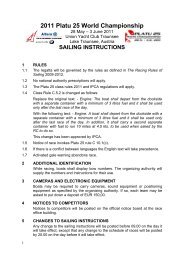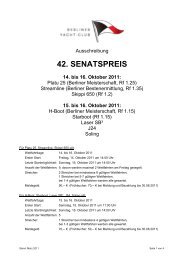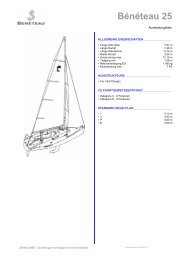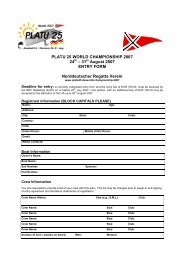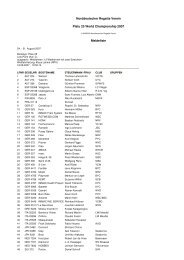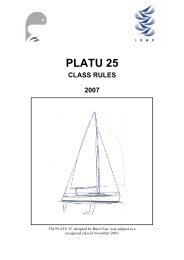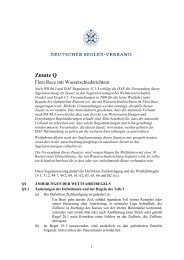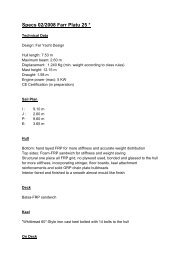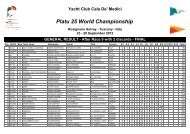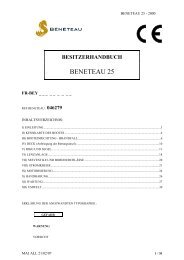NORTH SAILS ITALIA Bénéteau 25 O.D. Tuning Guide ... - Platu 25
NORTH SAILS ITALIA Bénéteau 25 O.D. Tuning Guide ... - Platu 25
NORTH SAILS ITALIA Bénéteau 25 O.D. Tuning Guide ... - Platu 25
Create successful ePaper yourself
Turn your PDF publications into a flip-book with our unique Google optimized e-Paper software.
<strong>NORTH</strong> <strong>SAILS</strong> <strong>ITALIA</strong><br />
In very light air we are looking for a smooth luff to keep the draft forward and make steering easy, and an<br />
open leech to reduce stalling. As the breeze increases we trim the sheet harder to power up. We also let some<br />
wrinkles show in the luff, which optimizes the genoa entry and enables you to point higher. When we reach<br />
maximum genoa conditions, we ease the sheet to open the slot and reducing heeling, and pull the luff smooth<br />
to keep the draft forward. The best way to obtain this is pulling and easing genoa Cunningham very<br />
frequently, following the wind and the waves.<br />
Some crews have purchased the genoa halyard. We don’t suggest it, unless your number 2 (central) hasn’t<br />
enough strength to tighten properly the halyard, because the fine trim of the luff is done perfectly using the<br />
genoa cunningham. Anyway, this is the way to purchase the halyard: place a padeye just underneath the<br />
genoa halyard sheave on the mast, under the top of the forestay. Then make the rope coming out of the mast<br />
there pass through a small block having a snap shackle to be fixed to the genoa and splice its end to the<br />
above padeye. Remember you will need approximately twice the length of the original halyard, but you can<br />
reduce the diameter of it. Even the light genoa has no problem to be fully hoisted using this system, as it has<br />
enough room from its head to the halyard sheave.<br />
The heavier your crew and the bigger the waves, the longer you can keep the genoa medium-light up. If the<br />
apparent wind is above 16-18 knots wind speed, it is time to change to the medium-heavy genoa. You don’t<br />
have to use other sails on your boat, unless you start in more than <strong>25</strong> knots true wind. That’s very rare in the<br />
Bénéteau <strong>25</strong> class… Never reef the mainsail. We sail normally 400 Kgs crew weight, try to be always close<br />
to this limit.<br />
Downwind – Spinnaker<br />
The spinnaker should be at full hoist at all times. The general rule of trim is to allow 5-10 cm of curl in the<br />
luff of the sail. The outboard end of the pole should be even with the free floating clew (move it continuously<br />
in order to obtain this result!) and the pole should remain perpendicular to the apparent wind. Use the upper<br />
pole ring for most conditions. If you are going slowly, try raising the pole a couple of inches.<br />
Downwind – light air: Concentrate on good communication between helmsman and spinnaker trimmer. The<br />
goal is to sail as low as possible while still maintaining good pressure in the spinnaker (measured by tension<br />
on the sheet). Try not to sail too high which translates into longer distances, but do not sail too low at a slow<br />
pace. Do not open too much the outboard end of the pole, it flattens the spinnaker. It is very important to<br />
constantly trim both the spinnaker guy and the spinnaker uphaul. Do not mind if you move the pole more<br />
than the spinnaker sheet, you are on the right way!<br />
Downwind – heavy air: Do not allow the pole to rest on the headstay at any time. Always maintain at least<br />
5-8 cm distance between the headstay and pole. When there are big puffs, ease the sheet 10-15 cm to help the<br />
boat accelerate. Trim as the puff subsides. Keep a hand on the vang, ready to release it if the boat starts to<br />
spin out. Hike very hard on the reaches.<br />
Downwind tips<br />
1. Pole height is important and changes in increments of 2 cm have a big effect on the spinnaker. The break<br />
(or curl) should appear at the front of the first central panel. If the spinnaker breaks higher than this, the pole<br />
is too low and should be raised. If the break is lower, the pole is too high and should be lowered.<br />
2. An efficient foreguy system is crucial. Every up and down, or back and forth motion of the pole (and<br />
hence the spinnaker) is wasted energy; that energy will not be pulling the boat forward.<br />
3. An efficient system for launching and retrieving the spinnaker is a must. We recommend a deep cockpit<br />
launching bag. Call us if you would like one made for your Bénéteau <strong>25</strong>.<br />
11




